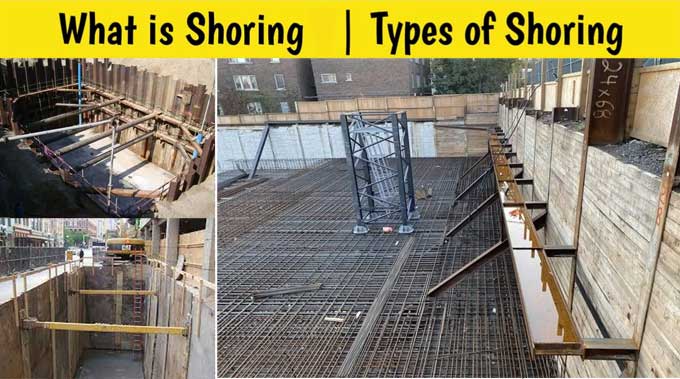
5 Basic Types of Shoring in Construction
Structure Supporting is the important thing in construction. A good engineer or architect does not want to see their construction collapse. That?s why Shoring is needed to support the structure to stop the collapse. Excavation is the most common shoring technique that is used at the beginning of the construction.
Shoring is used to support a deep excavation to stop the retained soil overturns that causes damage to the construction. The support shoring depends on soil type generally it supports an excavation at least 1.20 meters to 0 meters.
Shoring is different than any other construction type like wall retention; here shoring is just use to retain the soil during the excavation.
The 5 shoring types with the full guide are briefly discussed below. There are:
1. I or H Beams Shoring
I or H beam shoring is the most common shoring type which widely uses in a construction site. Prefabricated steel in I or H sections is being driven into the ground. The condition of soil permits the vibration of the section into the ground rather than soil pre-drilling before the beam installation. Installing precast concrete panels between the driven steel beams of shoring walls construction helps to form the wall.
Different type excavation range is used to support I or H beam Shoring.
- 1.2-5 meters is good for deep excavation or at least one basement depending on the structural design.
- Structural designers can go 5 meters and above on their design if they calculated sustain surcharge load along with outside perimeter.
2. Secant Pile Shoring
Secant Pile Shoring is created by intersecting two piles combinations. It has two types:
- The primary pipe also knows as a non-reinforced pipe.
- The secondary pipe also knows as reinforce pipe.
A guide beam is created before the installation to keep the alignment in place for deep excavation.
The temporary casing extracts after casting the primary pile at the time the concrete has not been set properly. After that heavy casing drives into the location where the piles are intervening and cut through the fresh concrete adjacent pile.
Then the secondary or reinforce pipe immediately drills. The secondary pipe steel cage includes and the structural pours to form a continuous wall.
Secant pipes can use perfectly in an open excavation where there is no room due to the existing structure is too close.
3. Contiguous Pile Shoring
Tangent Pile Shoring is also known as Contiguous Pile Shoring composes in close shape where the file faces are almost touching and tangent to each other. Minimal water pressure or there is no sign of water. Clay soil is perfect for this kind of shoring where it can retain dry rough material and fills. However, the water can seep through the pile gaps in water-bearing rough soils.
The Watertight retaining wall can be formed to prevent by grouting these gaps. High groundwater without dewatering works is bad for Contiguous Pile Shoring.
Contiguous Pile Shoring is as same as Secant Piles before the installation. A guide beam is created to serve as a support for installing the contiguous wall.
4. Sheet Piles
Sheet Piles use to hold soil in Soil excavation. This Shorting type use isolate excavation from the water bodies like a pond, creek, and a seaside. Port and Harbor Construction site use those sheet piles.
Just like soldier piles, Vibro hammers use to drive prefabricated U or Z Steel sections into the ground. These sheet files are connected to form the full wall. The excavation depth depends upon the short sheet piles end can be welded together to achieve the desired ground depth.
5. Diaphragm Walls
Diaphragm Walls uses in deep excavations. Reinforced concrete is mainly designed to resist the load. These types of shoring are used for both temporary retaining walls and permanent retaining walls. It can be the best choice for the deep excavation of the basement or tunnels.


